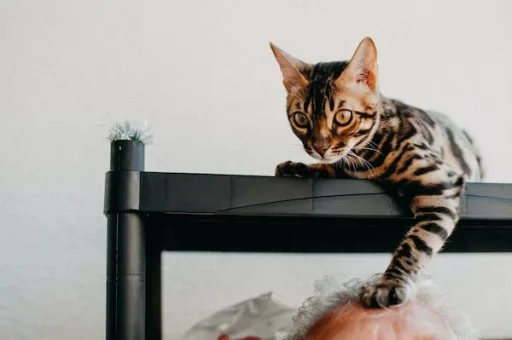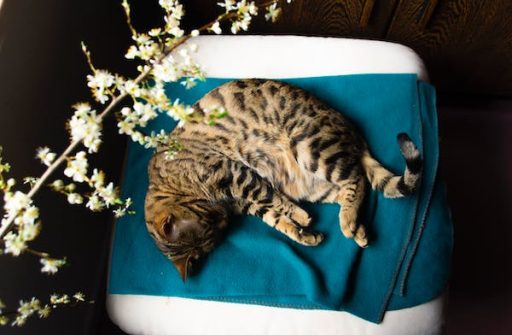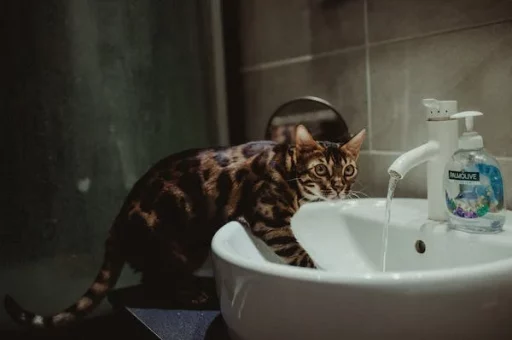
Bengals cat are neither hairless nor generate less Fel D1 protein than other breeds, so what makes them hypoallergenic? The solution is hidden under their clothes. Bengal cats have exceptionally fine pelts that require far less upkeep than other breeds. As a result of not grooming themselves as frequently or for as long, Bengals’ fur contains less allergen-rich saliva. They also don’t shed much compared to other cats, so whatever dander is in their fur isn’t dispersed around as much.
Bengals have made the top ten list of the most hypoallergenic cats for various reasons. Compared to most other breeds, most people allergic to cats have either no allergic reaction or a reduced sensitivity to Bengal cats.
Everything you need to know about Scottish Fold before purchasing it
This is thought to be the case for three primary reasons:
- Because Bengals are hybrids, they are only partially domestic and partially Asian Leopard cats. Their allergen-causing proteins may be enough distinct to prevent a response. This is the only theory because it has yet to be tested.
- Bengals have a single short, tight coating of hair called a pelt. Other domestic cats have two layers of fur, one undercoat and one topcoat. • Bengals have zero to minimal shedding and hence require less grooming, allowing less allergen-causing saliva to enter their pelt. Who wouldn’t desire a cat-hair-free home and clothes, not to mention no hairball issues? As a result, not only is there less saliva on a Bengal’s pelt but also less of that pelt traveling around and producing allergy symptoms.
- I have microfiber couches and have yet to find any pelts from my Bengal on any of my furniture or clothing. Human hair has been discovered between my broom and vacuum, but never cat hair. I’ve had numerous guests over to my house who are allergic to cats in general and did not react to my Bengals. To be honest, visiting a breeder’s home is the greatest method to find out whether you are allergic to Bengals.
Contents
- 1 Are Bengals cat hypoallergenic? Handy tips for new cat parents
- 2 Petcort elaborates:
- 3 Why are Bengals less prone than other breeds to trigger allergic reactions?
- 4 Symptoms that you may be allergic to your Bengal cat
- 5 Is it feasible to have Bengal cats while also having allergies?
- 6 Personal habits and hygiene
- 7 Environmental Factors
- 8 Bengals Cat Care
- 9 What role may healthy nutrition play?
Are Bengals cat hypoallergenic? Handy tips for new cat parents
Bengals make ideal companions for allergy sufferers, but no cat is completely hypoallergenic.
As a result, the answer to “Are Bengal cats hypoallergenic?” is no. The good news is that they are less prone than other cats to cause allergies, such as Maine Coons, Persians, and Norwegian Forest cats.
Petcort elaborates:
• What makes Bengals less prone than other breeds to cause allergic reactions?
• How will you know if you are allergic to your Bengal cat?
• Can allergic people coexist with these lovely little leopards?
What causes some individuals to be allergic to cats?
Allergies develop when our immune system reacts to foreign chemicals, perceives them as dangerous, and makes antibodies to combat them. When exposed to allergens, our systems usually initiate an inflammatory response in the nasal passages and lungs, resulting in moderate to severe responses.
Skin irritation indicates an allergic response, whereas more severe symptoms include acute swelling and anaphylaxis.
Why are Bengals less prone than other breeds to trigger allergic reactions?

Many people believe that cat fur is the source of an allergic reaction, however, this is not the case. Dander (dead skin) is the most concerning allergen for persons with allergies since it is small, airborne, and rapidly collects on furniture and clothing.
Other frequent allergy causes besides dander include:
- 1. spittle
- 2. Urine and feces
- 3. Perspiration
- 4. Tears
- 5. Mucous
They all include Fel d1, a protein that causes allergic responses in cats. It’s light and sticky, so it can linger and trigger sneezing even if your cat isn’t in the room. While certain breeds have low Fel d1 levels, the Bengal cat is not one of them.
Why are Bengal cats said to be hypoallergenic? Because all of the compounds on the list remain on felines’ fur, cats who shed excessively are more likely to irritate allergic individuals. Bengals have a single-layer coat and shed less, therefore humans who live with Bengals are less likely to come into touch with Fel d1.
Bengals have short coats that stick to their bodies. It gives them a smooth and silky appearance and doesn’t become filthy quickly, reducing the need for self-grooming. Because less grooming implies less shedding, Fel d1 doesn’t go everywhere.
Symptoms that you may be allergic to your Bengal cat

Even though Bengals seldom cause allergies, you should exercise caution if you have a history of allergic responses to cats or are a new parent. It would help if you spent some time (at least 24 hours) with a Bengal kitten before purchasing one.
Symptoms might be moderate or severe, especially if you have asthma or chronic bronchitis. The following table lists the most frequent allergy symptoms:
| Mild symptoms | Extreme symptoms |
| Sneezing and a runny noseRed, watery, and itchy eyesItchy nose and throatCoughFacial pressureRestless sleepSwollen under-eyes | Hives with swellingDifficulty breathingChest tightness or painWheezing sound while exhaling wheezingVomiting and diarrhoeaSevere skin rash |
Is it feasible to have Bengal cats while also having allergies?
People with lesser symptoms should have no issue adopting a Bengal cat. Antihistamines such as cetirizine and levocetirizine can be used to treat low-intensity allergies. You may probably avoid using medications if you take sufficient care and safeguards.
Doctors urge anyone suffering from more severe symptoms to avoid living with cats. Prolonged exposure can cause severe pain and, in extreme circumstances, anaphylactic shock. Because the only method to protect oneself is to avoid contact with the allergen, sharing your environment with a cat would be harmful.
To make your coexistence with your kitty as comfortable as possible, you’ll need to make changes on three levels:
- 1. Personal hygiene and habits
- 2. Environmental factors
- 3. Cat Welfare
Personal habits and hygiene
If you have allergies, you must restrict your exposure to your Bengal kitten, no matter how cute they are. You must:
- 1. Avoid caressing and hugging your cat (this may be difficult because Bengals are sociable and loving, but it is vital).
- 2. Wash your hands after caressing or grooming your pet.
- 3. Have someone else clean their litter box or educate them to go outdoors to do their business.
If your allergies persist despite these precautions, you will need to take medicine. Contact your doctor to establish the best course of action, particularly if you want to use antihistamines, decongestants, or allergy injections for an extended length of time.
Environmental Factors
Taking care of your environment is critical for reducing allergy problems. It is vital to maintain proper hygiene in your house, which includes the air and surfaces. • Use an air purification system—Because Fel d1 is airborne and tends to stay for a while, investing in a system such as HEPA (high-efficiency particulate air) can assist you in swiftly removing these particles. Avoid using standard fans and air conditioners in rooms where your cat usually goes.
Clean all surfaces regularly—Cat parents with allergies must properly clean their environment every day. Because allergens adhere to rugs, furniture, and clothing, you must cover every surface. Because fur clings to microfiber cleaning cloths, use these. Another strategy to keep Fel d1 at bay in your house is to get rid of carpets and draperies.
Bengals Cat Care
Taking care of your Bengal will improve their health and longevity, as well as keep your allergies away. Keep an eye out for:
1. Grooming—While Bengals may not require as much grooming as other breeds, brushing and cleaning them with a moist towel can keep loose dander from spreading around your home.
2. Nutrition—A proper diet keeps your Bengal’s skin hydrated and in good condition. Feeding your kitten a high-protein diet can prevent dry and flaky skin, and your nose will finally be relieved.
What role may healthy nutrition play?
Although you cannot completely eradicate cat allergies, a good diet will help limit shedding, preventing allergens from reaching you. A well-balanced diet will keep your kitty’s skin and coat moisturized and reduce dandruff.
The following are the foundations of any feline’s diet:
- 1. Protein derived from animals
- 2. Fat from animals
Protein derived from animals
Our feline pals are carnivores by nature. The only way to guarantee they develop is to feed them high-quality meat and seafood, such as chicken, turkey, tuna, and salmon.
• Muscle mass
• Silky coat
• Healthy skin
To acquire enough taurine—an important amino acid crucial for maintaining the appropriate function of organs, muscles, and the CNS (central nervous system)—your Bengal’s food should contain more than 50% animal protein.
If your Bengal doesn’t get enough animal protein in their diet, the quality of their coat will suffer, causing your allergies to flare up. Plant proteins are not a good substitute since felines cannot digest them. Peas, carrots, and broccoli are neither harmful nor dangerous to cats, but they do not provide the nutrients required to keep your cat healthy.
Fat from animals
Kitties can benefit from animal fat as a supplemental energy source. Fatty acids derived from animal fat are essential for maintaining the health of your Bengal skin and coat.
If your Bengal is a picky eater who rejects wet, dry, raw, or any other sort of food, try serving them a meal high in animal fat and observe how quickly they devour it. Kitties love animal fat because it enhances their flavor.
To minimize weight gain and related concerns such as obesity and diabetes, keep the proportion of fat in your feline’s food below 20%.
Foods to avoid if you have a Bengal
Avoiding some nutrients is just as crucial as adopting the proper ones when it comes to coat care:
- Commercial food using filler ingredients
- Foods containing common allergies (dairy, meat, cereals, and so on).
- toxic Contaminants (coffee, chocolate, grapes, or allium vegetables)
Which food is best for your Bengal’s skin and coat, wet, dry, or raw?
Bengals should eat wet canned food regularly to keep their skin and fur healthy and moisturized. Failure to maintain this balance and overfeeding your feline might result in:
- Flaky skin and poor-quality fur—Dehydration caused by a lack of moisture can cause skin elasticity to deteriorate.
- Weight gain—Because dry food is heavy in calories, excessive intake can contribute to obesity (particularly in adult cats, who do not require as many calories as kittens).
- Common feline diseases—Dry food may raise the risk of diabetes, constipation, UTIs, and other problems.
Because meat from the human supply chain is prone to contamination during storage and handling, a raw diet poses a risk of food poisoning and bacterial infections. If you wish to feed raw meat to your cat, you must follow the tightest hygienic regulations.






